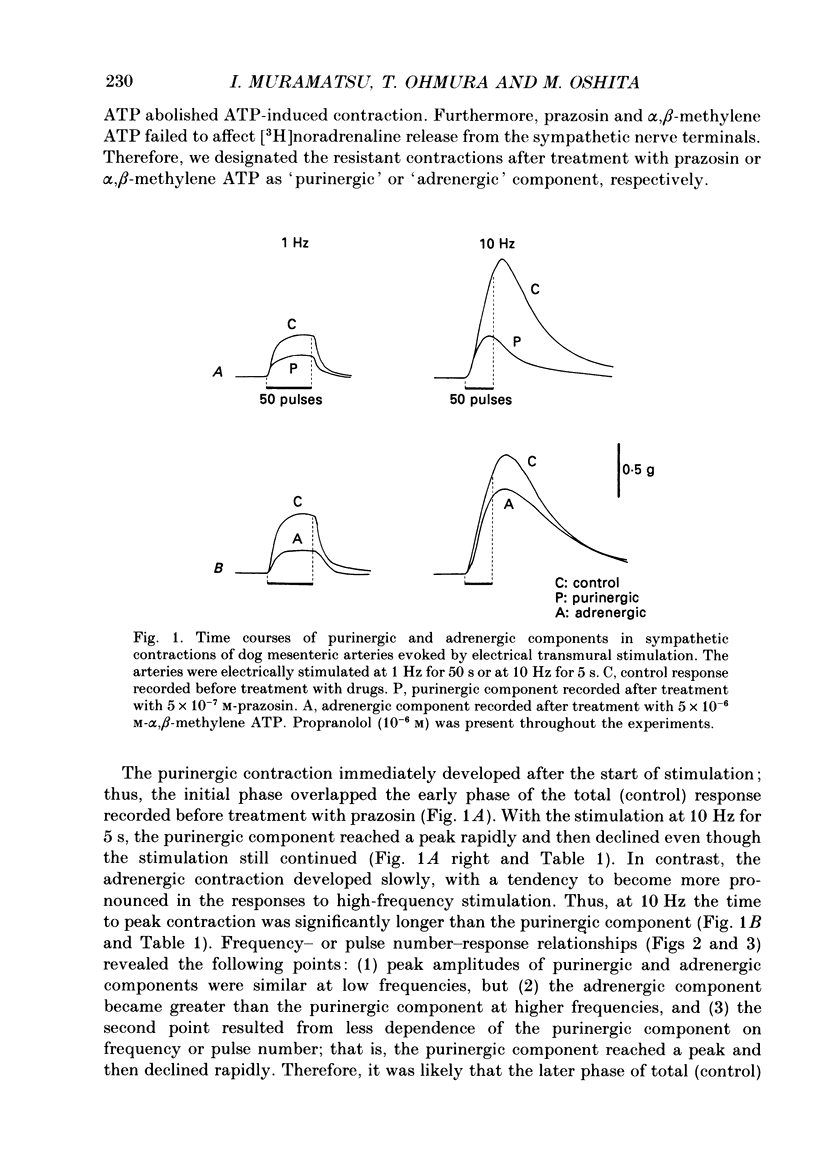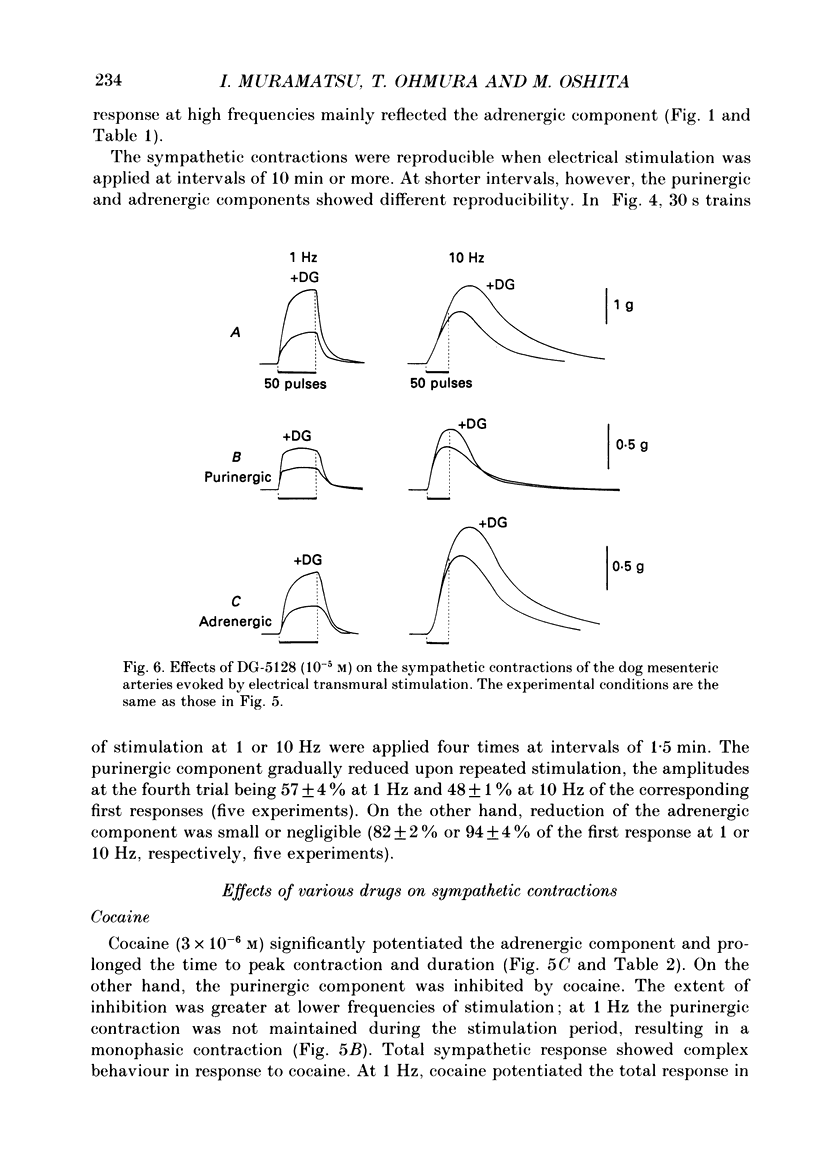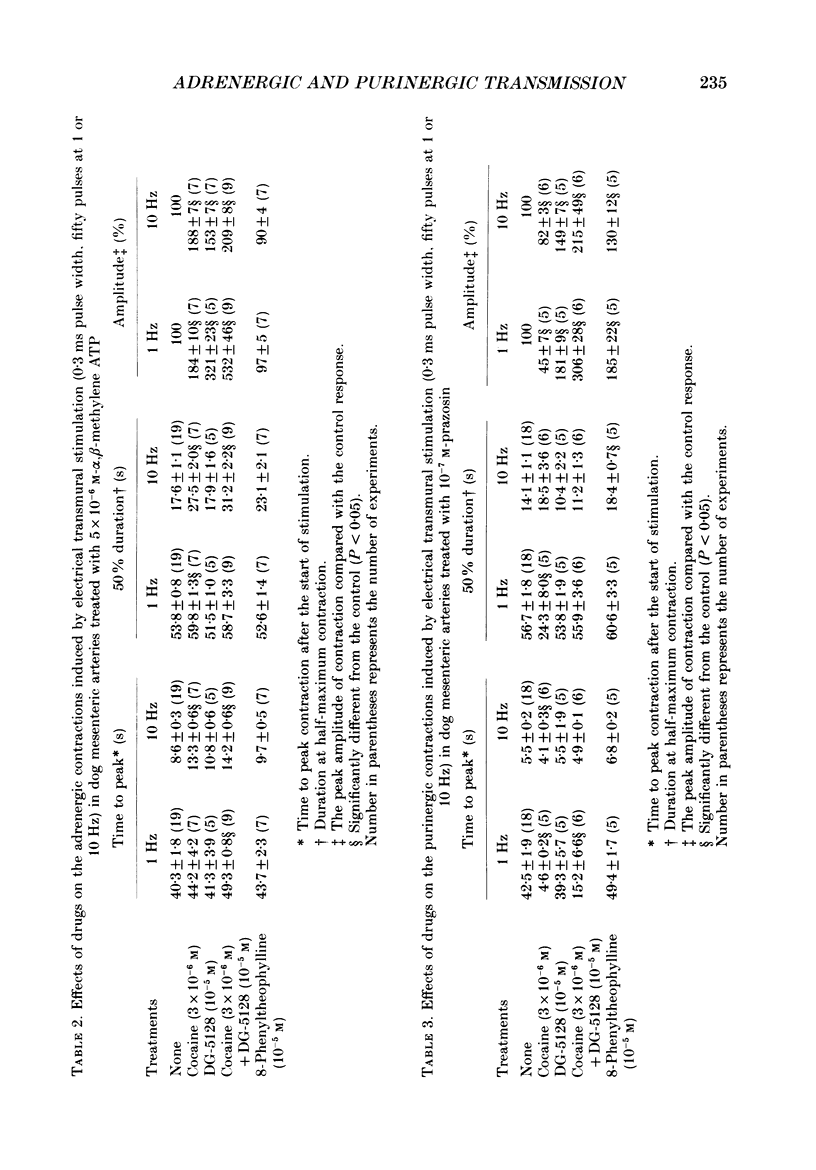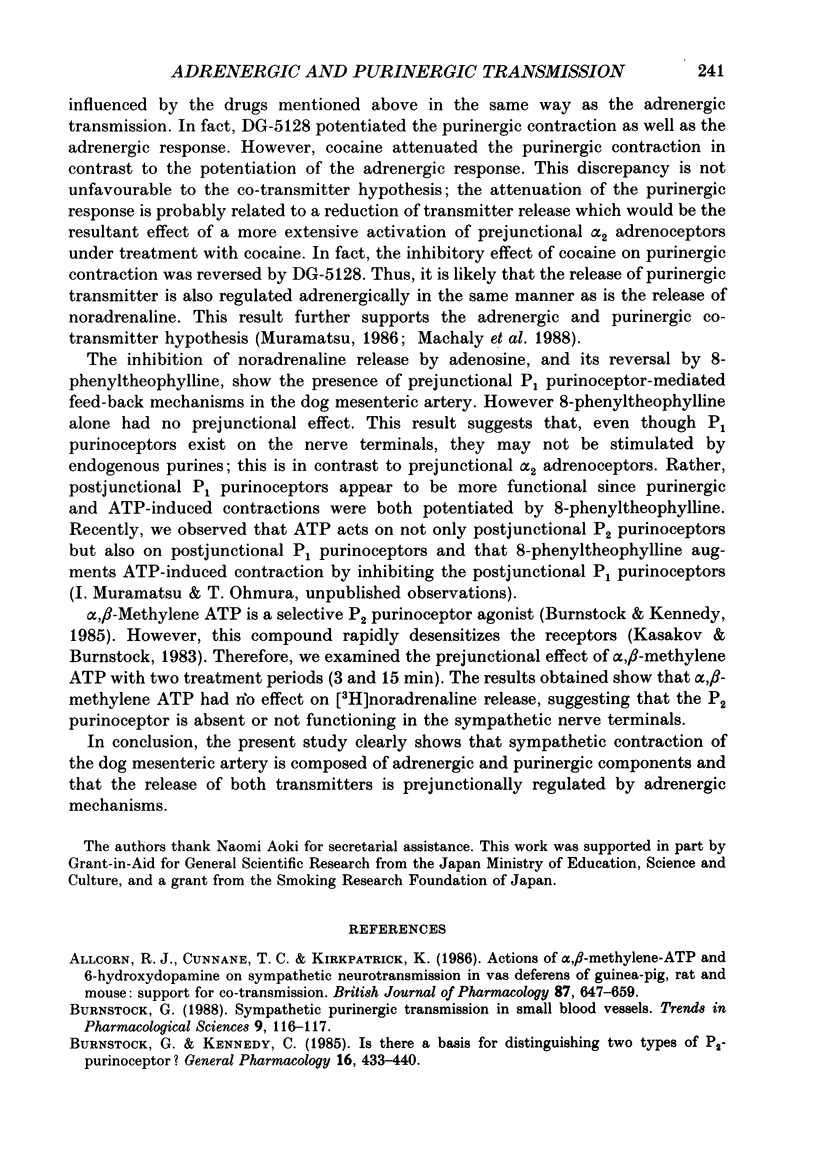Abstract
1. Electrical transmural stimulation evoked a sympathetic contraction in the isolated dog mesenteric artery. This contraction consisted of adrenergic and purinergic components, which were separately observed under conditions where postjunctional P2 purinoceptors were desensitized with alpha, beta-methylene ATP or postjunctional alpha 1 adrenoceptors were blocked by prazosin, respectively. 2. The purinergic component was transient and developed immediately after the start of stimulation and declined rapidly after a peak. In contrast, the adrenergic contraction slowly developed and lasted longer than the purinergic component. Thus, the purinergic and adrenergic components predominantly contributed to the early and later phases of the total sympathetic response, respectively. 3. The peak amplitudes of contraction of both components were similar at 1 Hz, but the adrenergic component occurred more dominantly in the responses to higher frequency stimulation. 4. Cocaine, a neuronal uptake inhibitor of noradrenaline, potentiated the adrenergic component but attenuated the purinergic component. This attenuation was reversed by DG-5128, a prejunctional alpha 2 adrenoceptor antagonist. Treatment with DG-5128 alone augmented both adrenergic and purinergic components. 5. 8-Phenyltheophylline, a P1 purinoceptor antagonist, potentiated the purinergic component without affecting the adrenergic component. 6. Exogenous noradrenaline produced a sustained contraction, which was potentiated by cocaine and was competitively inhibited by prazosin. alpha, beta-Methylene ATP and 8-phenyltheophylline had no effect on the response to noradrenaline. Exogenous ATP produced a transient contraction, which was abolished under conditions where postjunctional P2 purinoceptors were desensitized with alpha, beta-methylene ATP. 8-Phenyltheophylline potentiated but cocaine or prazosin did not affect the ATP response. 7. Electrical stimulation produced an increase in 3H efflux from the sympathetic nerve terminals in the mesenteric arteries pre-incubated with [3H]noradrenaline. The evoked efflux was significantly augmented by cocaine or DG-5128 and was inhibited by guanethidine or tetrodotoxin. alpha, beta-Methylene ATP and 8-phenyltheophylline were without effect. Adenosine reduced the 3H efflux and the inhibition was suppressed by 8-phenyltheophylline. 8. These results suggest that sympathetic contraction of the dog mesenteric artery is caused through not only adrenergic but also purinergic mechanisms, and that both the sympathetic transmissions are predominantly modulated through prejunctional adrenergic mechanisms.
Full text
PDF
















Selected References
These references are in PubMed. This may not be the complete list of references from this article.
- Allcorn R. J., Cunnane T. C., Kirkpatrick K. Actions of alpha, beta-methylene ATP and 6-hydroxydopamine on sympathetic neurotransmission in the vas deferens of the guinea-pig, rat and mouse: support for cotransmission. Br J Pharmacol. 1986 Dec;89(4):647–659. doi: 10.1111/j.1476-5381.1986.tb11169.x. [DOI] [PMC free article] [PubMed] [Google Scholar]
- Burnstock G., Kennedy C. Is there a basis for distinguishing two types of P2-purinoceptor? Gen Pharmacol. 1985;16(5):433–440. doi: 10.1016/0306-3623(85)90001-1. [DOI] [PubMed] [Google Scholar]
- Burnstock G. Sympathetic purinergic transmission in small blood vessels. Trends Pharmacol Sci. 1988 Apr;9(4):116–117. doi: 10.1016/0165-6147(88)90185-x. [DOI] [PubMed] [Google Scholar]
- Burnstock G., Warland J. J. A pharmacological study of the rabbit saphenous artery in vitro: a vessel with a large purinergic contractile response to sympathetic nerve stimulation. Br J Pharmacol. 1987 Jan;90(1):111–120. doi: 10.1111/j.1476-5381.1987.tb16830.x. [DOI] [PMC free article] [PubMed] [Google Scholar]
- Fedan J. S., Hogaboom G. K., O'Donnell J. P., Colby J., Westfall D. P. Contribution by purines to the neurogenic response of the vas deferens of the guinea pig. Eur J Pharmacol. 1981 Jan 5;69(1):41–53. doi: 10.1016/0014-2999(81)90600-2. [DOI] [PubMed] [Google Scholar]
- Ganten D., Lang R. E., Archelos J., Unger T. Peptidergic systems: effects on blood vessels. J Cardiovasc Pharmacol. 1984;6 (Suppl 4):S598–S607. [PubMed] [Google Scholar]
- Kasakov L., Burnstock G. The use of the slowly degradable analog, alpha, beta-methylene ATP, to produce desensitisation of the P2-purinoceptor: effect on non-adrenergic, non-cholinergic responses of the guinea-pig urinary bladder. Eur J Pharmacol. 1982 Dec 24;86(2):291–294. doi: 10.1016/0014-2999(82)90330-2. [DOI] [PubMed] [Google Scholar]
- Kennedy C., Saville V. L., Burnstock G. The contributions of noradrenaline and ATP to the responses of the rabbit central ear artery to sympathetic nerve stimulation depend on the parameters of stimulation. Eur J Pharmacol. 1986 Apr 2;122(3):291–300. doi: 10.1016/0014-2999(86)90409-7. [DOI] [PubMed] [Google Scholar]
- Langer S. Z. Presynaptic regulation of catecholamine release. Biochem Pharmacol. 1974 Jul 1;23(13):1793–1800. doi: 10.1016/0006-2952(74)90187-7. [DOI] [PubMed] [Google Scholar]
- Lundberg J. M., Tatemoto K. Pancreatic polypeptide family (APP, BPP, NPY and PYY) in relation to sympathetic vasoconstriction resistant to alpha-adrenoceptor blockade. Acta Physiol Scand. 1982 Dec;116(4):393–402. doi: 10.1111/j.1748-1716.1982.tb07157.x. [DOI] [PubMed] [Google Scholar]
- Machaly M., Dalziel H. H., Sneddon P. Evidence for ATP as a cotransmitter in dog mesenteric artery. Eur J Pharmacol. 1988 Feb 16;147(1):83–91. doi: 10.1016/0014-2999(88)90636-x. [DOI] [PubMed] [Google Scholar]
- Meldrum L. A., Burnstock G. Evidence that ATP is involved as a co-transmitter in the hypogastric nerve supplying the seminal vesicle of the guinea-pig. Eur J Pharmacol. 1985 Apr 16;110(3):363–366. doi: 10.1016/0014-2999(85)90565-5. [DOI] [PubMed] [Google Scholar]
- Muramatsu I. Evidence for sympathetic, purinergic transmission in the mesenteric artery of the dog. Br J Pharmacol. 1986 Mar;87(3):478–480. doi: 10.1111/j.1476-5381.1986.tb10187.x. [DOI] [PMC free article] [PubMed] [Google Scholar]
- Muramatsu I., Fujiwara M., Miura A., Sakakibara Y. Possible involvement of adenine nucleotides in sympathetic neuroeffector mechanisms of dog basilar artery. J Pharmacol Exp Ther. 1981 Feb;216(2):401–409. [PubMed] [Google Scholar]
- Muramatsu I., Hollenberg M. D., Lederis K. Modulation by epidermal growth factor--urogastrone of contraction in isolated canine helical mesenteric arterial strips. Can J Physiol Pharmacol. 1986 Dec;64(12):1561–1565. doi: 10.1139/y86-262. [DOI] [PubMed] [Google Scholar]
- Muramatsu I., Kigoshi S., Oshita M. Nonadrenergic nature of prazosin-resistant, sympathetic contraction in the dog mesenteric artery. J Pharmacol Exp Ther. 1984 May;229(2):532–538. [PubMed] [Google Scholar]
- Muramatsu I., Kigoshi S. Purinergic and non-purinergic innervation in the cerebral arteries of the dog. Br J Pharmacol. 1987 Dec;92(4):901–908. doi: 10.1111/j.1476-5381.1987.tb11396.x. [DOI] [PMC free article] [PubMed] [Google Scholar]
- Muramatsu I., Oshita M., Yamanaka K. Selective alpha-2 blocking action of DG-5128 in the dog mesenteric artery and rat vas deferens. J Pharmacol Exp Ther. 1983 Oct;227(1):194–198. [PubMed] [Google Scholar]
- Muramatsu I. The effect of reserpine on sympathetic, purinergic neurotransmission in the isolated mesenteric artery of the dog: a pharmacological study. Br J Pharmacol. 1987 Jul;91(3):467–474. doi: 10.1111/j.1476-5381.1987.tb11238.x. [DOI] [PMC free article] [PubMed] [Google Scholar]
- Sneddon P., Burnstock G. ATP as a co-transmitter in rat tail artery. Eur J Pharmacol. 1984 Oct 30;106(1):149–152. doi: 10.1016/0014-2999(84)90688-5. [DOI] [PubMed] [Google Scholar]
- Sneddon P., Burnstock G. Inhibition of excitatory junction potentials in guinea-pig vas deferens by alpha, beta-methylene-ATP: further evidence for ATP and noradrenaline as cotransmitters. Eur J Pharmacol. 1984 Apr 13;100(1):85–90. doi: 10.1016/0014-2999(84)90318-2. [DOI] [PubMed] [Google Scholar]
- Sneddon P., Meldrum L. A., Burnstock G. Control of transmitter release in guinea-pig vas deferens by prejunctional P1-purinoceptors. Eur J Pharmacol. 1984 Oct 15;105(3-4):293–299. doi: 10.1016/0014-2999(84)90621-6. [DOI] [PubMed] [Google Scholar]
- Sneddon P., Westfall D. P. Pharmacological evidence that adenosine triphosphate and noradrenaline are co-transmitters in the guinea-pig vas deferens. J Physiol. 1984 Feb;347:561–580. doi: 10.1113/jphysiol.1984.sp015083. [DOI] [PMC free article] [PubMed] [Google Scholar]
- Starke K. Regulation of noradrenaline release by presynaptic receptor systems. Rev Physiol Biochem Pharmacol. 1977;77:1–124. doi: 10.1007/BFb0050157. [DOI] [PubMed] [Google Scholar]
- Vanhoutte P. M., Verbeuren T. J., Webb R. C. Local modulation of adrenergic neuroeffector interaction in the blood vessel well. Physiol Rev. 1981 Jan;61(1):151–247. doi: 10.1152/physrev.1981.61.1.151. [DOI] [PubMed] [Google Scholar]
- Westfall D. P., Fedan J. S., Colby J., Hogaboom G. K., O'Donnell J. P. Evidence for a contribution by purines to the neurogenic response of the guinea-pig urinary bladder. Eur J Pharmacol. 1983 Mar 4;87(4):415–422. doi: 10.1016/0014-2999(83)90080-8. [DOI] [PubMed] [Google Scholar]
- von Kügelgen I., Starke K. Noradrenaline and adenosine triphosphate as co-transmitters of neurogenic vasoconstriction in rabbit mesenteric artery. J Physiol. 1985 Oct;367:435–455. doi: 10.1113/jphysiol.1985.sp015834. [DOI] [PMC free article] [PubMed] [Google Scholar]


